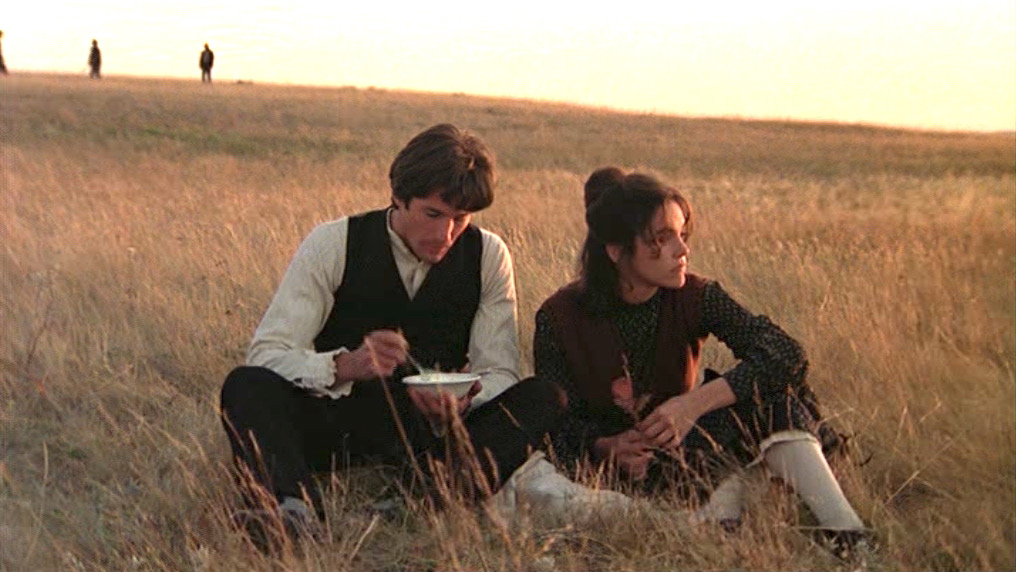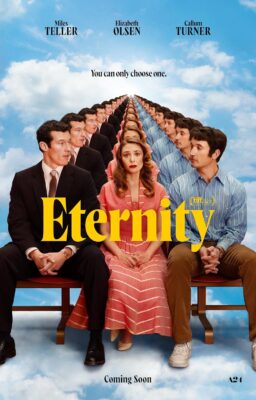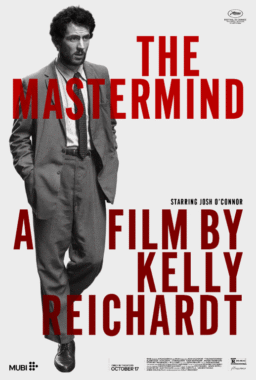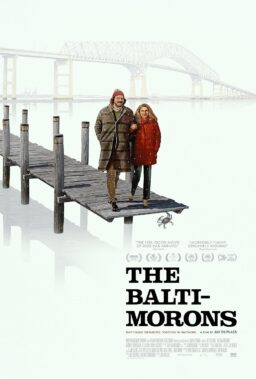Peter Labuza’s “Approaching the End: Imagining Apocalypse in American Film“ is now available online and in stores. The publisher was kind enough to provide an excerpt about the timeless “Days of Heaven.” The synopsis of the book is below, followed by the excerpt.
Tracing a timeline from World War II to the present day, Approaching the
End rethinks apocalyptic cinema by considering its relationship to file
noir, the fatalist crime genre of the 1940s to 1950s that remained
pervasive through Hollywood’s changing tides. Challenging the common
notion of apocalyptic films as special effects destroying cities through
natural disasters and alien invasions, Labuza examines films that truly
push humanity to the edge, considering why certain American works have
imagined our ends. Starting with the explosive Kiss Me Deadly, the book
examines various apocalyptic scenarios and how each ties together
through issues of displacement and amorality: from the atomic anxiety of
The Big Heat and Lady from Shanghai, to the religious peril of Days of
Heaven and The Rapture, to science fiction dystopias of The Terminator
and They Live, and ending with the media implosion that is Richard
Kelly’s Southland Tales. As diverse as these films may appear on the
surface, Labuza investigates the hidden structures underneath, which
reveal how apocalyptic narratives explore the darker edges of humanity’s
moral failings.
“Days of Heaven” as
Religious Noir

Both “The Rapture” and “God Told Me To” present direct
conflicts with faith and their protagonists in a form of skepticism about
belief. It is this search for salvation, and the impossibility of such a search
that underlies the final film in this chapter—Terrence Malick’s “Days of Heaven.”
Yes, that Malick film; the one with characters pondering over wheat fields,
with magic hour shots, and the sort of transcendentalism that has defined his
other works, such as “The New World” (2005) and “The Tree of Life” (2011). As
much as this initially sounds like a stretch, I am not the first to identify
the noir aspect of the film—David Thomson notes that while Malick’s camera
acts like it is “seen through immense cultural telescope of documentarian
and historian Ken Burns,” he declares
the plot fundamentally noir. Similarly, Matt Zoller Seitz posits
that the main plot “sounds like the greatest novel James M. Cain never
wrote.” And, of course, Malick’s previous film “Badlands” (1973) also
featured a similar, fundamentally noir plot that was challenged by Malick’s
tone—specifically the film’s oddly harmonious score and Sissy Spacek’s
voiceover, which was spoken by a young girl but represented the thoughts of a
Buddhist.
Thus, if we separate the images of “Days of Heaven” from the
actual A-to-B-to-C plot, we find a noir narrative taking shape, and I think the
interplay between this noir plot against the Malickian backdrop is key. The
film follows lovers on the run Bill and Abby (along with Bill’s young sister,
Linda) as they make their way west after a murder in Chicago. Bill then
attempts to steal the fortune of a dying farm owner through a plan of sexual
betrayal using Abby. What is essentially at odds here is that this land—the
Texan plains in the 1910s—is supposed to represent an escape from the pains and
chaos of the city, a glorious Eden. Instead, these characters fall into the
same traps as before, and the physical territory that promised openness and life
becomes one of destruction. “Days of Heaven” thus might be one of the most
cynical noirs because it essentially translates noir out of the confines of the
1940s and -50s urban moment and into the most idyllic of spaces—anything is now
corruptible.
The plot begins with murder in the urban world of a steel
mill in Chicago. When Bill and his foreman get into a scuffle (what their fight
is really about gets drowned out by the sound of machines), the death of the
foreman results from an accidental outburst of violence. Malick’s closeup on
Bill’s face emphasizes his surprise that the blow was fatal. Bill might believe
the land outside the city will provide solace, but he finds the opposite, and
he again turns toward a defiant act. When Bill and the farmer later fight at
the end of the film, Malick repeats the confused look on Bill’s face in closeup
as he stabs him, suggesting that his violent behavior is not so much conscious
as inherent to his being. Like Jeff Bailey in “Out of the Past,” he seems
doomed to repeat his actions, emphasized through the repeated musical cue of
Ennio Morricone’s score as the “heading west” narrative starts a
second time after they leave the farm. “Days of Heaven” examines how the
accidental aspects of violence are more inherent to Bill than a product of his
environment (the film is certainly not a case of urban anxiety). The repeated
gesture of Bill’s murders suggests his own personal temporal dislocation. No
matter how many times he can “begin again” (to place it in a
Christian context), he will still commit the mortal sin.
But “Days of Heaven” operates on both a microcosmic and
macrocosmic scale, juxtaposing Bill’s tragedy with the constant deconstruction
of these myths. The film literally begins in myth with the film’s opening
credits: a series of sepia-toned photographs accompanied by Camille Saint-Saëns’s
“Carnival of the Animals” creating the immigrant narrative, an
“innocent” time that is set before the First World War (the presence
of an Italian fighter plane is more a curiosity than a sign of annihilation).
The narrative is also that of the promise of the American West, a society where
one can begin life anew. And even more essential to the film’s noir narrative
is the allegorical uses of Biblical allusions. Malick presents only a brief
glimpse of Bill’s factory life, and posits a cure to his urban anxiety by
traveling to the “Promised Land”— Hubert Cohen notes
that the film’s title comes from a reference to the “land of milk and
honey” in Deuteronomy. The physical land thus acts as a temporal space of
the past, a time of innocence made into a physical space. However, this supposed
spatial heaven, which seems like the promise of an afterlife, has been plagued
with the same troubles as human society. Bill is cheated out of his wages,
scorned by others for his love of Abby, and still sees himself as
“below” others, most notably the farmer who can possess all he wants
(at least from Bill’s perspective). His vision of a land of plenty is turned to
a land of little, so he turns toward sin once again in order to claim what he
believes is his. By plotting against the farmer (a plan that goes awry when the
farmer sees the two kissing in silhouette, a shot that directly recalls film
noir’s shadows), the film turns its biblical images from ones of hope to ones
of destruction through Old Testament references and imagery. In Genesis,
Abraham attempts to pass off his wife Sarah as his sister, which is repeated
here as Bill tells others that Abby is his sister. While Abraham does this to
preserve Sarah’s innocence, Bill instead uses this deception to force Abby to
betray the farmer’s trust, knowing he will die soon. Sarah marries the King of
Egypt but God’s intervention prevents a sexual betrayal. Bill, trying to play
the role of God, forces Abby to not just bed the farmer, but continue to join
him in midnight trysts at the river. While it is Abby who commits the betrayal,
Bill forces it—it is his eyes that look upon the land in desire and decides to
break out of his current situation. He defies his status as a low-wage worker
in a beautiful landscape, thus reclaiming his own autonomy.
Malick juxtaposes the human conflict with the conflict of
nature through biblical, apocalyptic imagery—the swarms of locusts, but
especially the repeated depictions of fire. There are fires in the opening
shots at the factory; in an early moment of the harvest, as the camera gazes
into one of the tractors; in a brief mention by Linda during the voiceover
recalling Ding-Dong’s story of an apocalyptic fire; and then, finally, during
the fire that destroys the crops. Bill’s fights with the farmer seem to be what
leads to the plague over the society, and by the end he has burned down this
Eden. He then dies by literally plunging into the water, which Malick frames
from below like a baptism, as if death is the only way he can return to a state
of innocence (Figure 3-3). The film’s various biblical allusions are all given
noir-like twists, as Bill does not find rebirth in this land of innocence, but
instead finds himself in another version of the same unforgiving landscape, and
is thus compelled to commit the same defiant acts.
The apocalyptic visions of the narrative thus act as a
cosmic expansion of temporal dislocation. From Adam and Eve to now Bill and
Abby, the story of man’s fall repeats itself again and again—the plot in
repetition, much like in “Out of the Past.” Malick reminds the spectator of
these past myths, enacting this story into the larger cosmos. His camera thus
takes a disinterested stance, focusing instead on the images of wheat and sky,
seeing Bill’s plot as a natural event as common as the seasons. As the voiceover
by Linda explains, “If you’ve been bad, God don’t even hear you. He don’t
even hear ya talkin’.” Bill never realizes he is only a small part of this
great human narrative, that his actions are meaningless within the greater
scope of the world’s movements. It is perhaps crucial that Malick’s film does
not end with Bill’s death, as he undermines it by following Linda’s narrative
instead, showing how the repetition begins again as Linda escapes her school
for the wheat fields in the final shot, less an ending than a feeling that the
reels in the camera have run out. Even in attempting to break out of the
repetition, Bill ends up as part of a larger narrative outside himself,
temporally dislocated from even the plot of his own film, creates a world
wherein this destructive postwar dislocation is more universal, the anxieties
present in noir no longer specific to one time or place. His characters see an
actual space as somewhere the return to innocence can be achieved, by searching
out a land literally set in the past, but it contains the same failures as
always: The defiant act instead leads to his own destruction. And through it
all, the hint of apocalyptic doom hangs in the air—World War I is on the
horizon, and before the farm has burned down, his foreman tells him that the
harvests are becoming worse and worse. The flames have stopped, but perhaps
they will continue; the innocent girl has escaped into the wild again.
Malick’s films have always been noted for their seeming
indifference to the world, or better said, the harmonious act that connects man
to nature in one grand schema of “all things shining” to quote a
character from “The Thin Red Line” (1998). It is interesting to note which
Malick films embrace this feeling wholeheartedly and which ones rely on the
undercurrent. “Badlands,” “The Thin Red Line,” and “The Tree of Life” have all
been about the search for peace in a world of violence and meaninglessness. But
for me, Malick’s three masterpieces are his films that work the opposite: “Days
of Heaven,” “The New World,” and his last film, “To the Wonder” (2012). The
latter two feature characters that are pure embodiments of nature and harmony,
only to be contained and fenced in, the modern world always encroaching on
nature. “Days of Heaven” remains Malick’s most poignant because it is also
about characters searching for redemption in nature, in God’s physical Eden,
only to find that their promise of a new beginning will once again become
trapped and contained, eventually consumed by the fires of the end times. Who knows
how long this world will last? The fires will always travel on.











